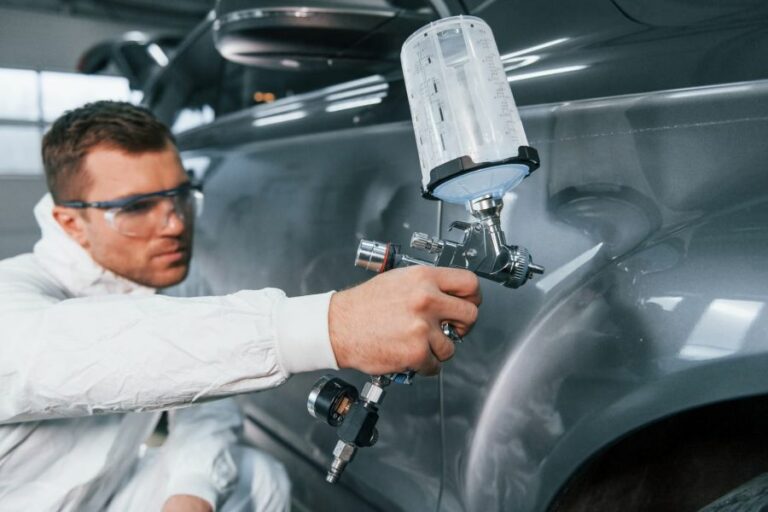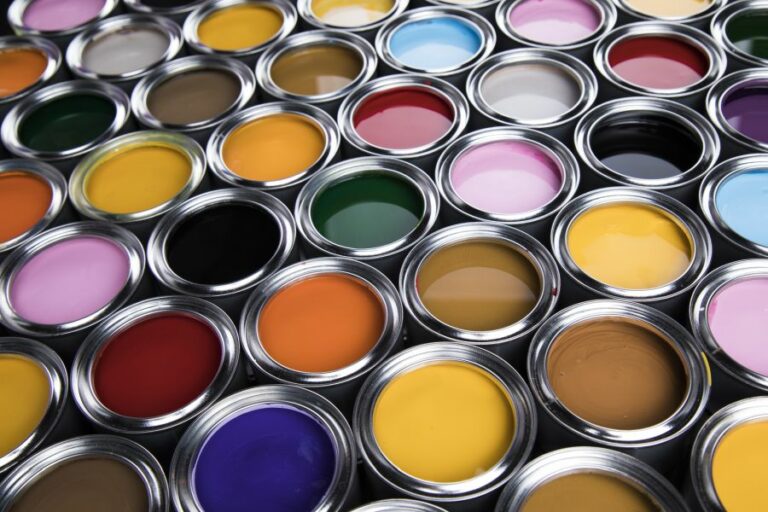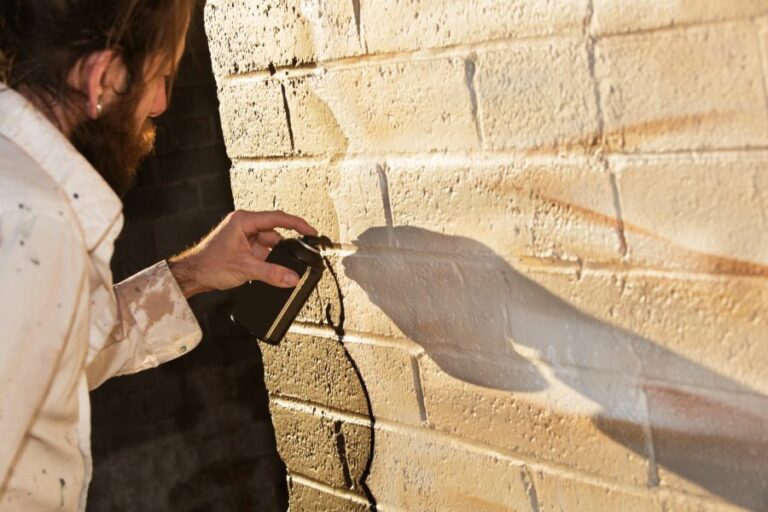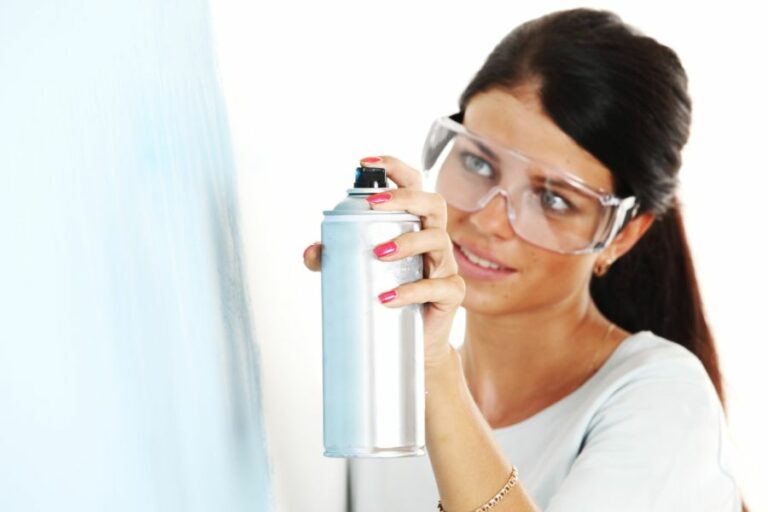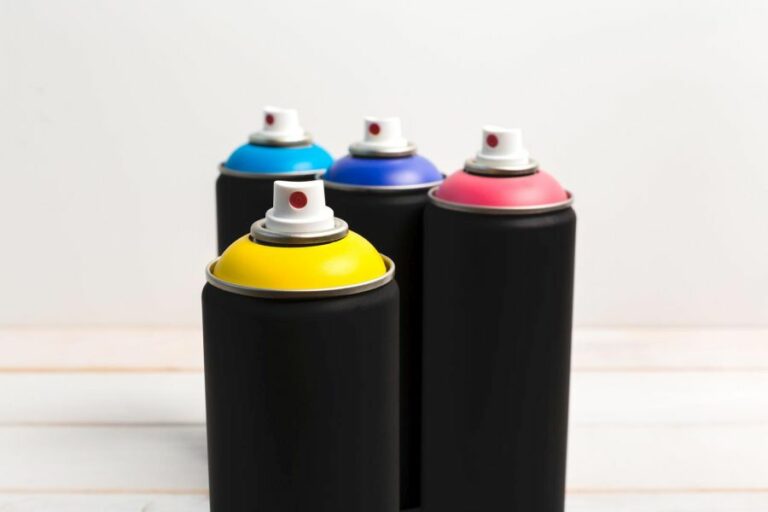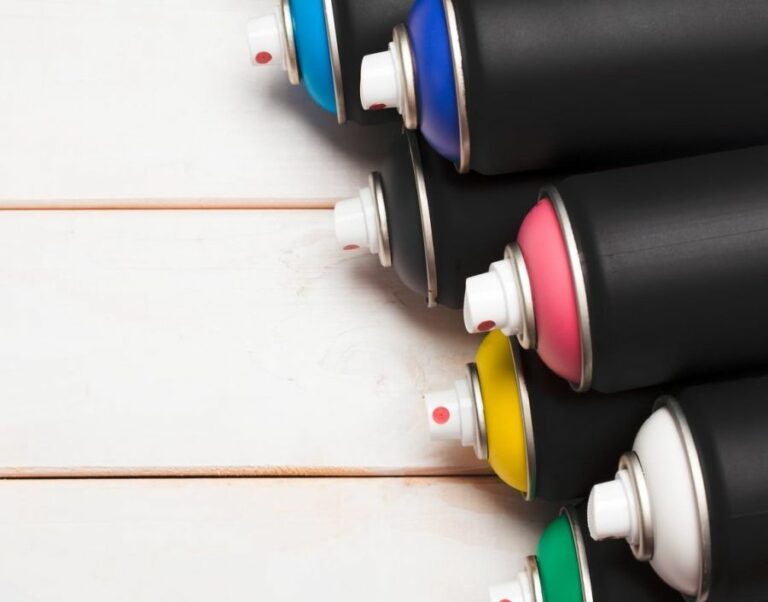Safety Tips For Using UV Spray Paint. What Pros Say
UV spray paint can be a fun and creative way to add a glowing touch to your projects. But safety always comes first. We’ve gathered essential safety tips to ensure you get the best results while staying protected. Let us guide you through the process and help you avoid potential hazards when working with this unique medium.
Safety tips for using uv spray paint:
To safely use UV spray paint, ensure proper ventilation in your workspace, wear personal protective equipment (PPE) like goggles, a respirator mask, gloves, and protective clothing, follow the manufacturer’s instructions, apply paint in thin layers, dispose of paint waste according to local regulations, store spray paint correctly, be informed about the risks, choose a quality product, be mindful of heavy metals, and seek medical help if experiencing adverse symptoms.

Excited to experiment with UV spray paint but worried about staying safe during the creative process? Fret not! We’ve got you covered with essential safety tips and tricks to make your artwork truly shine while keeping you protected. Read on to unleash your inner artist without any setbacks!
Contents
- 1 Preventive Measures for Using UV Spray Paint Safely
- 1.1 • 1. Properly Ventilate Your Workspace
- 1.2 • 2. Wear Suitable Personal Protective Equipment (PPE)
- 1.3 • 3. Follow the Manufacturer’s Instructions
- 1.4 • 4. Apply the Paint in Thin Layers
- 1.5 • 5. Properly Dispose of Paint Waste
- 1.6 • 6. Store Spray Paint Correctly
- 1.7 • 7. Be Informed About the Risks
- 1.8 • 8. Choose a Quality Product
- 1.9 • 9. Be Mindful of Heavy Metals
- 1.10 • 10. Know When to Seek Help
- 2 Essential Safety Measures When Handling Spray Paint
- 3 Duration of Spray Paint Fumes’ Harmful Effects
- 4 Importance of Protective Eyewear during Spray Painting
Preventive Measures for Using UV Spray Paint Safely
UV spray paint, or ultraviolet-reactive paint, is a popular choice for various artistic and industrial applications due to its unique ability to glow under black light. However, like any other type of paint, it is essential to follow safety precautions when using this product.
• 1. Properly Ventilate Your Workspace
When using any spray paint, including UV spray paint, it is crucial to have adequate ventilation to prevent the buildup of harmful fumes. Working in a well-ventilated area helps to ensure that you are not breathing in any dangerous chemicals or particles.
To create a well-ventilated workspace, open windows, and doors or use an exhaust fan to promote airflow in the room. If possible, perform your painting projects outdoors for optimal ventilation.
• 2. Wear Suitable Personal Protective Equipment (PPE)
To protect yourself from potential risks associated with UV spray paint, it is essential to wear the proper PPE. The items you should have include the following:
– Safety Goggles
Protect your eyes from paint particles and fumes by wearing safety goggles or glasses. Look for models with side shields to offer maximum protection.
– Respirator Mask
Using a respirator mask that is specially designed for spray paint applications helps to filter out harmful fumes and particles. Ensure that the mask fits correctly and replace the filters as recommended by the manufacturer.
– Gloves
Wear disposable gloves when working with UV spray paint to protect your skin from coming into contact with potentially harmful chemicals. Nitrile or latex gloves are suitable choices.
– Protective Clothing
Cover your skin with long sleeves, long pants, and closed-toe shoes to minimize skin exposure to paint particles and fumes.
• 3. Follow the Manufacturer’s Instructions
Before using any UV spray paint product, read the manufacturer’s instructions carefully, and follow their guidelines. This information will provide you with essential safety information and application tips for optimal results.
• 4. Apply the Paint in Thin Layers
Applying UV spray paint in thin, even layers will not only produce a better finish but will also reduce the risk of paint dripping or pooling, which can create an even greater hazard.
• 5. Properly Dispose of Paint Waste
When disposing of UV spray paint waste, such as empty cans, used gloves, or contaminated rags, ensure that you follow local hazardous waste regulations. Contact your local waste disposal facility for guidance on the proper disposal of these items.
• 6. Store Spray Paint Correctly
Always store spray paint cans in a cool, dry place, away from heat sources or open flames. Also, keep them out of reach of children and pets.
• 7. Be Informed About the Risks
Understanding the potential health risks associated with using UV spray paint is vital. Prolonged exposure to paint fumes can lead to respiratory issues, skin irritation, and in some instances, damage to the nervous system.
The Centers for Disease Control and Prevention (CDC) provides some additional information on the risks associated with working with paint products, which can help you make informed decisions about safety precautions.
• 8. Choose a Quality Product
Investing in a high-quality UV spray paint product can impact not only the quality of your finished project but also your safety. Look for brands with a reputation for producing non-toxic and low-odor products, as this may reduce the potential risks associated with using UV spray paint.
• 9. Be Mindful of Heavy Metals
Some UV spray paints may contain heavy metals, such as cadmium or lead, which can be harmful if inhaled or ingested. Always check the product’s safety and technical data sheet to ensure its ingredients are safe to use.
• 10. Know When to Seek Help
If you experience symptoms such as difficulty breathing, skin irritation, dizziness, or nausea while working with UV spray paint, seek medical attention immediately. These symptoms may indicate a reaction to the fumes or chemicals in the paint and require prompt medical intervention.
By following these safety tips for using UV spray paint, you can protect yourself, others, and the environment while enjoying the creative possibilities of this unique medium. With proper precautions, you can safely explore the world of UV reactive art while minimizing potential risks.
Essential Safety Measures When Handling Spray Paint
Spray paint is an incredible tool for various DIY projects, art, and home improvement tasks. However, it’s essential to take necessary precautions to ensure safe and effective use.
• Choose the Right Environment
Always work in a well-ventilated area when using spray paint. Fumes can be harmful when inhaled, and proper ventilation will provide you with enough fresh air, ensuring your safety. Ideally, work outdoors or in an open garage. If you must work indoors, open windows and doors for proper airflow.
• Wear Appropriate Protective Gear
– Respirator Mask
Wearing a respirator mask is crucial when using spray paint. A mask will protect you from inhaling harmful vapors and paint particles. I recommend using a half-face respirator mask with filters suitable for organic vapors and particulates.
– Gloves
Wearing gloves will protect your hands from paint and chemicals. Choose disposable nitrile gloves, which are resistant to many chemicals and offer excellent protection.
– Safety Goggles
To protect your eyes from paint particles and fumes, wear safety goggles. Ensure they fit well and provide a good seal around your eyes.
– Protective Clothing
Wear long sleeves and pants to protect your skin from paint exposure. Consider using a disposable coverall to avoid ruining your clothes.
• Shake the Can Well
Before using the spray paint, shake the can vigorously for the recommended time (usually around 1-2 minutes). This will ensure proper mixing of the paint and guarantee a smooth, even application.
• Maintain Proper Distance and Angle
Hold the can approximately 10-12 inches away from the surface you’re painting. Maintaining this distance will help you achieve an even coat and reduce the risk of drips. Additionally, spray at a 90-degree angle for optimal coverage.
• Apply Multiple Thin Coats
Applying multiple thin coats will give you a smoother finish and prevent drips or runs. Allow each coat to dry according to the manufacturer’s instructions before applying the next one.
• Test the Spray Paint on a Scrap Piece
Before painting your actual project, test the spray paint on a scrap piece of material similar to the one you’re working on. This will help you get familiarized with the paint’s coverage, drying time, and finish.
• Prevent Clogging
After using the spray paint, turn the can upside down and spray until only clear gas comes out. This will clear the nozzle of any paint residue and prevent clogging for the next use.
• Store Spray Paint Properly
Proper storage of spray paint is essential for safety and preserving the quality of the paint. Store the cans in a cool, dry area away from direct sunlight or heat sources. Keep them out of reach of children and pets.
• Dispose of Empty Cans Safely
When you’ve finished a can of spray paint, follow your local government’s disposal guidelines for proper and safe disposal.
In conclusion, taking the necessary precautions while using spray paint will ensure the safety and success of your projects. Remember to choose a well-ventilated area, wear appropriate protective gear, and follow best practices for application and storage. Happy painting!
Duration of Spray Paint Fumes’ Harmful Effects
Spray paint is a versatile and widely used medium in various industries such as automotive, construction, and art. However, the convenience of spray paint comes with a downside to the fumes it emits during and after application.
• Duration of Harmful Spray Paint Fumes
Spray paint contains volatile organic compounds (VOCs), which evaporate into the air, causing a strong odor and potentially harmful fumes. The length of time these fumes remain harmful depends on several factors, such as the type of paint, the amount used, and the ventilation in the area.
– Type of Paint
Different kinds of spray paint have varying levels of VOCs. Standard, oil-based spray paints typically contain high amounts of VOCs, while water-based or low-VOC paints contain fewer chemicals. The more hazardous the paint composition, the longer the fumes may be harmful to those exposed.
The US Environmental Protection Agency (EPA) states that VOCs can cause short and long-term health effects, ranging from headaches and dizziness to respiratory issues and cancer. Thus, choosing low-VOC spray paints is highly recommended to reduce these risks.
– Amount of Paint Used
Naturally, larger projects require more paint, which will result in a higher concentration of fumes. It can take longer for these fumes to disperse and become less harmful. For smaller projects, the harmful fumes may disperse more quickly.
– Ventilation
Proper ventilation is crucial in minimizing the harmful effects of spray paint fumes. A well-ventilated space can help disperse the fumes faster, reducing their harmful effects. In contrast, poorly ventilated areas can trap fumes for longer periods, which increases the risk of inhaling these toxic substances.
• Precautions to Minimize Exposure to Harmful Fumes
To protect yourself and others from the harmful effects of spray paint fumes, follow these precautionary measures:
1. Use Low-VOC Spray Paint
Opt for spray paints labeled as low-VOC or water-based, which contain fewer harmful chemicals. Not only do these options emit less odor, but they also lessen the risk of adverse health effects.
2. Work in a Well-Ventilated Area
Always spray paint in a well-ventilated space, such as outdoors or in a room with open windows and doors. If you must work indoors, use fans or exhaust systems to improve air circulation and help disperse fumes faster.
3. Wear Protective Gear
Wearing appropriate protective gear is essential to minimize exposure to harmful fumes. A proper respirator with filters designed for organic vapor and particulates is highly recommended. Additionally, wear goggles, gloves, and long-sleeved clothing to protect your skin and eyes.
4. Follow the Manufacturer’s Instructions
Carefully read and follow the manufacturer’s safety guidelines listed on the product label. This information can provide vital details about the specific paint’s composition, recommended safety precautions, and proper handling techniques.
5. Take Regular Breaks
When painting for an extended period, take regular breaks to limit your exposure to fumes. Step away from the painting area, go outdoors or to a well-ventilated space, and breathe fresh air. This practice helps reduce the risk of overexposure and allows you to recover from inhaling any fumes.
6. Dispose of Unused Paint Properly
Do not leave open cans of paint or used rags in your workspace, as they can continue to emit harmful fumes. Dispose of them according to your local waste management regulations to minimize exposure risks.
• Conclusion
Spray paint fumes can be harmful to varying degrees, depending on the type of paint, amount used, and ventilation in the area. By choosing low-VOC paints, working in well-ventilated spaces, and following safety precautions, you can effectively minimize the risks associated with harmful fumes.
Remember, safety should always be a priority when working with potentially hazardous materials.
Criteria | Duration |
|---|---|
Indoors | At least 2-3 days |
Outdoors | 24 hours or less |
Well-Ventilated Space | Several hours |
General Timeframe for Residual Smell | 1-2 weeks or more |
Risk of Health Effects | Varies, depending on the duration of exposure and individual sensitivities |
Importance of Protective Eyewear during Spray Painting
As an experienced painter, I cannot stress enough the importance of appropriate safety measures when working with any type of paint. Safety glasses, in particular, play a crucial role in protecting your vision while spray painting.
Let’s delve into the reasons why wearing safety glasses while spray painting is a must and explore some key considerations when selecting the right pair.
– Reducing the Risk of Eye Injuries
Spray painting generates small airborne particles that can easily enter the eyes, causing irritation and potentially severe eye injuries. This risk is greater when painting in confined spaces or when working at different angles.
The National Institute for Occupational Safety and Health (NIOSH) has noted that eye injuries are among the most common workplace accidents. Wearing safety glasses significantly reduces the risk of such injuries when spray painting.
– Protecting Against Harmful Chemicals
Many paints contain harmful chemicals that can cause eye irritation, burns, or even long-term damage. Safety glasses act as a barrier between these chemicals and your eyes, ensuring protection and preventing dangerous exposure.
It is essential to choose safety glasses with the appropriate level of protection for the chemicals you are working with.
– Preventing Foreign Bodies
Spray painting often involves working with various surfaces, which can increase the risk of foreign objects, such as dust or debris, entering the eyes. Wearing safety glasses minimizes this risk and ensures that you can maintain clear vision throughout the entire painting process.
– Meeting Legal Requirements
In many countries, safety glasses are considered mandatory personal protective equipment (PPE) for certain spray painting activities, particularly in professional settings. Meeting these legal requirements not only safeguards your vision but also helps you avoid potential penalties or fines.
• Selecting the Right Safety Glasses
With a wide variety of safety glasses available in the market, choosing the right pair for your needs can be overwhelming. To make an informed decision, consider the following points before making a purchase:
– Comfort and Fit
When wearing safety glasses for an extended period, comfort is crucial. Look for glasses that are lightweight and have adjustable straps or temples to secure them snugly around your face. The ideal pair should not cause discomfort or slip during use.
– Type of Coverage
Depending on your work environment and the type of spray paint you are undertaking, different levels of coverage may be required.
Options include traditional safety glasses, goggles, or full-face shields. Goggles and face shields provide more comprehensive coverage, whereas safety glasses are typically lighter and may be more comfortable for prolonged wear.
– Lens Material
Safety glasses are made with various lens materials, the most common of which are polycarbonate, trivex, and glass.
Polycarbonate and trivex lenses are lightweight and more impact-resistant, while glass lenses may offer greater clarity. However, glass lenses are heavier and can shatter upon impact, posing additional risks.
– Anti-Fog Coating
As spray painting can generate moisture, it is essential to choose safety glasses with an anti-fog coating. This feature ensures that your vision remains clear and unobstructed even in high humidity or when wearing a face mask or respirator.
– UV Protection
Many spray paint formulations contain solvents that emit ultraviolet (UV) radiation. Overexposure to UV radiation can damage the eyes, necessitating safety glasses with lenses that offer UV protection.
• My Recommendation
Based on my personal experience, I recommend the use of safety goggles with an elastic strap, which offers a more secure fit than traditional safety glasses. Additionally, opting for goggles with indirect venting minimizes fogging and reduces the risk of chemical splash exposure.
In conclusion, wearing safety glasses while spray painting is a crucial precautionary measure that should not be overlooked.
Keep in mind the factors mentioned above when selecting your safety glasses, and make informed choices to ensure the best possible protection for your eyes during any spray painting project. Remember, safety comes first!

